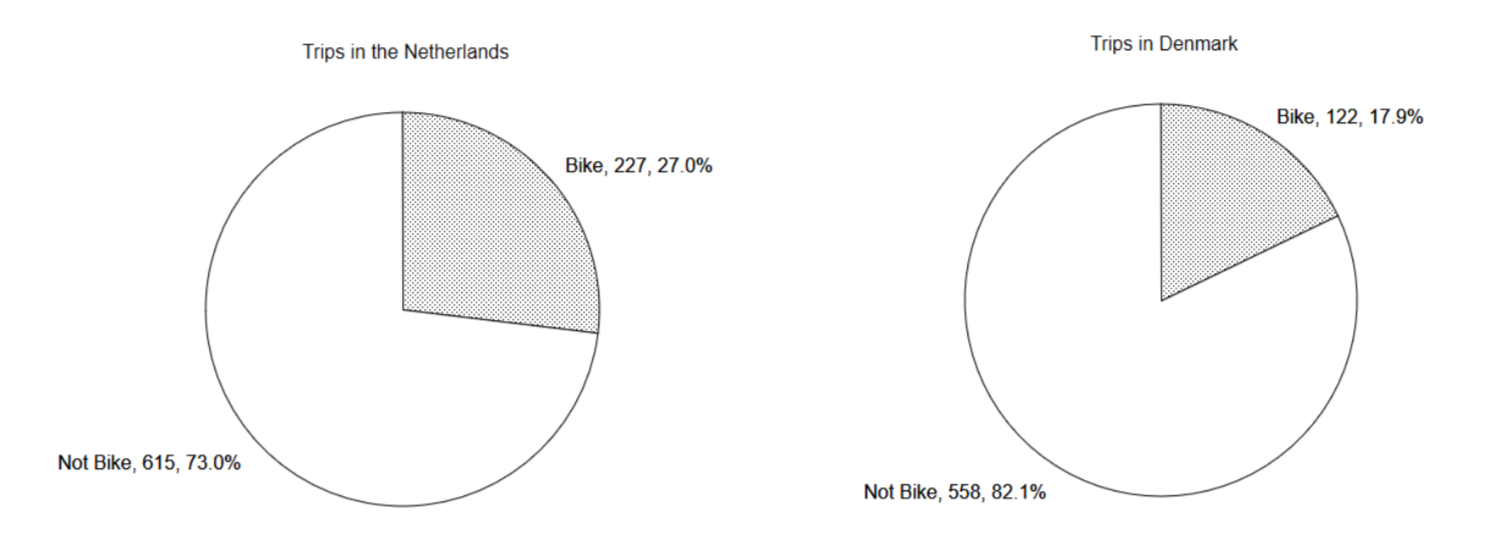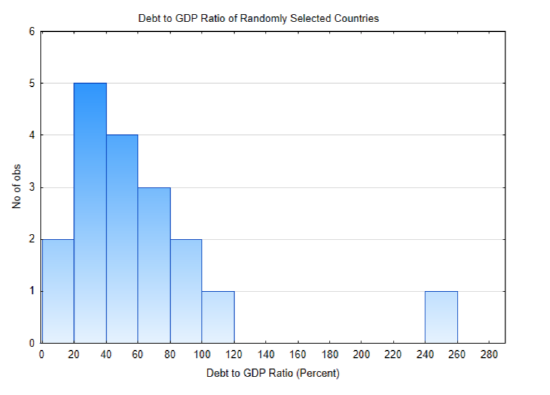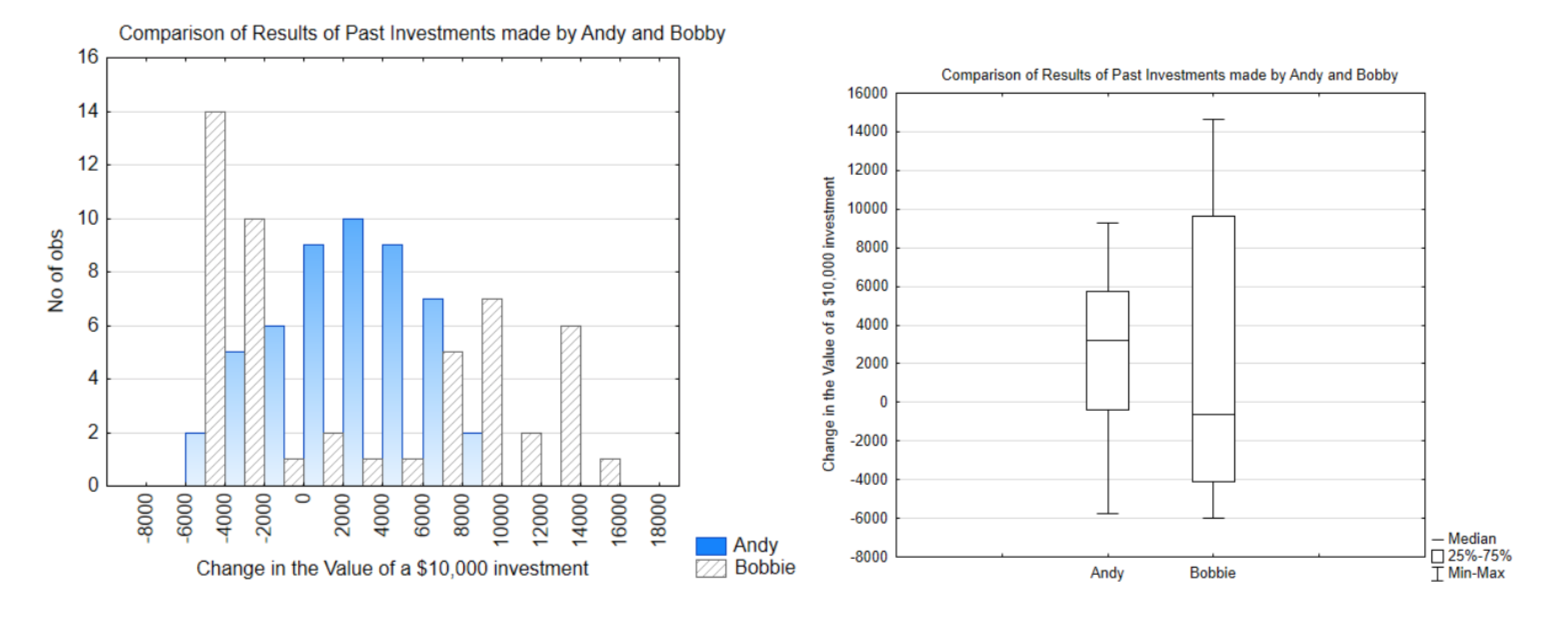10: Communication of Statistical Results
- Page ID
- 5449
\( \newcommand{\vecs}[1]{\overset { \scriptstyle \rightharpoonup} {\mathbf{#1}} } \)
\( \newcommand{\vecd}[1]{\overset{-\!-\!\rightharpoonup}{\vphantom{a}\smash {#1}}} \)
\( \newcommand{\dsum}{\displaystyle\sum\limits} \)
\( \newcommand{\dint}{\displaystyle\int\limits} \)
\( \newcommand{\dlim}{\displaystyle\lim\limits} \)
\( \newcommand{\id}{\mathrm{id}}\) \( \newcommand{\Span}{\mathrm{span}}\)
( \newcommand{\kernel}{\mathrm{null}\,}\) \( \newcommand{\range}{\mathrm{range}\,}\)
\( \newcommand{\RealPart}{\mathrm{Re}}\) \( \newcommand{\ImaginaryPart}{\mathrm{Im}}\)
\( \newcommand{\Argument}{\mathrm{Arg}}\) \( \newcommand{\norm}[1]{\| #1 \|}\)
\( \newcommand{\inner}[2]{\langle #1, #2 \rangle}\)
\( \newcommand{\Span}{\mathrm{span}}\)
\( \newcommand{\id}{\mathrm{id}}\)
\( \newcommand{\Span}{\mathrm{span}}\)
\( \newcommand{\kernel}{\mathrm{null}\,}\)
\( \newcommand{\range}{\mathrm{range}\,}\)
\( \newcommand{\RealPart}{\mathrm{Re}}\)
\( \newcommand{\ImaginaryPart}{\mathrm{Im}}\)
\( \newcommand{\Argument}{\mathrm{Arg}}\)
\( \newcommand{\norm}[1]{\| #1 \|}\)
\( \newcommand{\inner}[2]{\langle #1, #2 \rangle}\)
\( \newcommand{\Span}{\mathrm{span}}\) \( \newcommand{\AA}{\unicode[.8,0]{x212B}}\)
\( \newcommand{\vectorA}[1]{\vec{#1}} % arrow\)
\( \newcommand{\vectorAt}[1]{\vec{\text{#1}}} % arrow\)
\( \newcommand{\vectorB}[1]{\overset { \scriptstyle \rightharpoonup} {\mathbf{#1}} } \)
\( \newcommand{\vectorC}[1]{\textbf{#1}} \)
\( \newcommand{\vectorD}[1]{\overrightarrow{#1}} \)
\( \newcommand{\vectorDt}[1]{\overrightarrow{\text{#1}}} \)
\( \newcommand{\vectE}[1]{\overset{-\!-\!\rightharpoonup}{\vphantom{a}\smash{\mathbf {#1}}}} \)
\( \newcommand{\vecs}[1]{\overset { \scriptstyle \rightharpoonup} {\mathbf{#1}} } \)
\( \newcommand{\vecd}[1]{\overset{-\!-\!\rightharpoonup}{\vphantom{a}\smash {#1}}} \)
\(\newcommand{\avec}{\mathbf a}\) \(\newcommand{\bvec}{\mathbf b}\) \(\newcommand{\cvec}{\mathbf c}\) \(\newcommand{\dvec}{\mathbf d}\) \(\newcommand{\dtil}{\widetilde{\mathbf d}}\) \(\newcommand{\evec}{\mathbf e}\) \(\newcommand{\fvec}{\mathbf f}\) \(\newcommand{\nvec}{\mathbf n}\) \(\newcommand{\pvec}{\mathbf p}\) \(\newcommand{\qvec}{\mathbf q}\) \(\newcommand{\svec}{\mathbf s}\) \(\newcommand{\tvec}{\mathbf t}\) \(\newcommand{\uvec}{\mathbf u}\) \(\newcommand{\vvec}{\mathbf v}\) \(\newcommand{\wvec}{\mathbf w}\) \(\newcommand{\xvec}{\mathbf x}\) \(\newcommand{\yvec}{\mathbf y}\) \(\newcommand{\zvec}{\mathbf z}\) \(\newcommand{\rvec}{\mathbf r}\) \(\newcommand{\mvec}{\mathbf m}\) \(\newcommand{\zerovec}{\mathbf 0}\) \(\newcommand{\onevec}{\mathbf 1}\) \(\newcommand{\real}{\mathbb R}\) \(\newcommand{\twovec}[2]{\left[\begin{array}{r}#1 \\ #2 \end{array}\right]}\) \(\newcommand{\ctwovec}[2]{\left[\begin{array}{c}#1 \\ #2 \end{array}\right]}\) \(\newcommand{\threevec}[3]{\left[\begin{array}{r}#1 \\ #2 \\ #3 \end{array}\right]}\) \(\newcommand{\cthreevec}[3]{\left[\begin{array}{c}#1 \\ #2 \\ #3 \end{array}\right]}\) \(\newcommand{\fourvec}[4]{\left[\begin{array}{r}#1 \\ #2 \\ #3 \\ #4 \end{array}\right]}\) \(\newcommand{\cfourvec}[4]{\left[\begin{array}{c}#1 \\ #2 \\ #3 \\ #4 \end{array}\right]}\) \(\newcommand{\fivevec}[5]{\left[\begin{array}{r}#1 \\ #2 \\ #3 \\ #4 \\ #5 \\ \end{array}\right]}\) \(\newcommand{\cfivevec}[5]{\left[\begin{array}{c}#1 \\ #2 \\ #3 \\ #4 \\ #5 \\ \end{array}\right]}\) \(\newcommand{\mattwo}[4]{\left[\begin{array}{rr}#1 \amp #2 \\ #3 \amp #4 \\ \end{array}\right]}\) \(\newcommand{\laspan}[1]{\text{Span}\{#1\}}\) \(\newcommand{\bcal}{\cal B}\) \(\newcommand{\ccal}{\cal C}\) \(\newcommand{\scal}{\cal S}\) \(\newcommand{\wcal}{\cal W}\) \(\newcommand{\ecal}{\cal E}\) \(\newcommand{\coords}[2]{\left\{#1\right\}_{#2}}\) \(\newcommand{\gray}[1]{\color{gray}{#1}}\) \(\newcommand{\lgray}[1]{\color{lightgray}{#1}}\) \(\newcommand{\rank}{\operatorname{rank}}\) \(\newcommand{\row}{\text{Row}}\) \(\newcommand{\col}{\text{Col}}\) \(\renewcommand{\row}{\text{Row}}\) \(\newcommand{\nul}{\text{Nul}}\) \(\newcommand{\var}{\text{Var}}\) \(\newcommand{\corr}{\text{corr}}\) \(\newcommand{\len}[1]{\left|#1\right|}\) \(\newcommand{\bbar}{\overline{\bvec}}\) \(\newcommand{\bhat}{\widehat{\bvec}}\) \(\newcommand{\bperp}{\bvec^\perp}\) \(\newcommand{\xhat}{\widehat{\xvec}}\) \(\newcommand{\vhat}{\widehat{\vvec}}\) \(\newcommand{\uhat}{\widehat{\uvec}}\) \(\newcommand{\what}{\widehat{\wvec}}\) \(\newcommand{\Sighat}{\widehat{\Sigma}}\) \(\newcommand{\lt}{<}\) \(\newcommand{\gt}{>}\) \(\newcommand{\amp}{&}\) \(\definecolor{fillinmathshade}{gray}{0.9}\)In Algebra or other deterministic math, if you substitute numbers into a formula and calculate the answer, then the results can be reported without too much additional thought. However, with statistics, there is not necessarily one simple answer. Rather, it is necessary to consider all the evidence that can be understood from the sample. This means a careful interpretation of the graphs, and evaluation of the statistics, and a consideration of the test of significance. To simply rely on a p-value, or conversely ignore it all together, are both problematic. A p-value is important, but it is not sacred.
In this chapter you will be given graphs, statistics, and p-values. Your task will be to give a written explanation that is justified by the results. You should provide context as well as reference to the evidence. Before writing, you should answer the following questions in your mind.
1. What is the context? What is the story about and what is the purpose?
2. What does the graph show? Think about the distribution. Do you see any patterns or outliers?
3. Look at the statistics. Do they do a good job of representing the distribution shown in the graph?
4. Identify the hypothesis test. Is it appropriate?
5. Does the p-value indicate the data are significant? Keep in mind that significant and important are not synonymous. Is the evidence strong or weak? Use a 5% level of significance for all problems.
There should be a flow to your writing.
- It should begin with background information to provide context. This should include a statement of the objective or the question to be answered.
- Once the context has been provided, write about the evidence that you can gather from the graphs and the statistics.
- Since you have only been given sample data, it is necessary to make an inference. This is where you will write a concluding sentence such as you have been practicing throughout this text.
- Write a conclusion that directly answers the question and is consistent with the evidence and inference. If some of the evidence is contradictory, address the contradictions.
There are three communication activities to do. More direction is given with the first than the others. They increase in point values as your writing should improve each time. The first should be submitted after the exam on Chapter 1. The second should be submitted after the exam on Chapter 3, and the third should be submitted after the exam on Chapter 6.
Effective Communication 1 (due the day after the exam on Chapter 1)
Name _____________________________________ Points ______/4 (-1 per day for late)
The information presented below is about a comparison of the proportion of trips made by bicycle between The Netherlands and Denmark, the two top countries in the world for bicycling. A sample was taken of people in the Netherlands and Denmark. They were asked about the mode of transportation used during the last trip they made from their home to another destination. The data is whether the trips were made by bike or other mode of transportation. The objective is to determine if the proportion of trips by bicycle is higher in the Netherlands than Denmark.(http://top10hell.com/top-10-countrie...es-per-capita/ Viewed 6/21/17) On the back of this page, write your analysis legibly, or type it. There are guides about what should be written.

Results of hypothesis test: p-value = 0.000016.
Section 1. Write about the context. What is this information about? Why might it be of interest? What is the question that is being asked? Try to engage the reader.
Section 2. Give evidence. This is where you explain the distribution of the data and give the statistics. Make use of all relevant statistics and evidence from the graph.
Section 3. Make an inference. This is where you write the concluding sentence to extend the results from the sample to the population. Make sure it is phrased in a way that is consistent with the question being asked in Section 1. Include p-value and sample sizes.
Section 4. Conclusion. Provide a direct answer to the question, being consistent with the evidence and inference.
Effective Communication 2 (due the day after the exam on Chapter 3)
Name _____________________________________ Points ______/8 (-2 per day for late)
The current national debt of the United States is about 20 trillion dollars. While this number sounds high (okay, it is high), there is a difference if a country of the size of the US has a 20 trillion dollar national debt compared with a country the size of Bermuda (for example). Therefore, one thing economists will do is to find the ratio of the national debt of a country to the Gross Domestic Product (GDP) for the country. The current ratio for the US is 106. This means that the debt is 106% of the GDP. The information below will allow you to determine if the average debt to GDP ratio for other randomly selected countries is less than the US.2 The US is not included in the distribution below.

Mean: 60.8, Median: 45.2, Minimum: 3.1, Max: 250.4 (Japan), Standard Deviation: 54.1
Hypothesis Test Results: P-value = 0.0012, n = 18.
Write an analysis that compares the debt to GDP ratio of other countries to the US. Include context, statistics and a statement of significance. Use good grammar and spelling. Write legibly or type.
Organize your writing in the order that was done in the first effective communication activity, give background and context followed by evidence, inference, and then conclusion.
Effective Communication 3 (due the day after the exam on Chapter 6)
Name _____________________________________ Points ______/12 (-3 per day for late)
The CEO of an investment company is trying to fill a position of Senior Investment Manager. Two investment advisors are applying for the same position. You have been given the task of analyzing the success of the investments they managed for their clients. The data that you will compare is the change in the value of the investment for each $10,000 that is invested. For example, if the investment grew to $12,400, then the change would be $2,400. However, if the investment shrank to $6500, the change would be -$3,500. Below you will find graphs, statistics and the results of a hypothesis test that compares the two investment managers, Andy and Bobbie (note, these names can be used for males and females, so you can use whichever pronouns you want, e.g. him or her). Your objective is to write a report that compares the two and make a recommendation. You must justify your recommendation.

| Andy | Bobbie | |
| Mean | 2537.74 | 2550.76 |
| Median | 3220.50 | -635.50 |
| Standard Deviation | 3736.56 | 7112.00 |
| n | 50 | 50 |
The results of a t-test for 2 independent means to test for a difference between means are t = -0.011, p = 0.991.
Write an analysis to help the CEO make a choice between Andy and Bobbie. Include context, statistics and a statement of significance. Use good grammar and spelling. Write legibly or type. Organize your writing in a similar way to the other effective communication activities.


